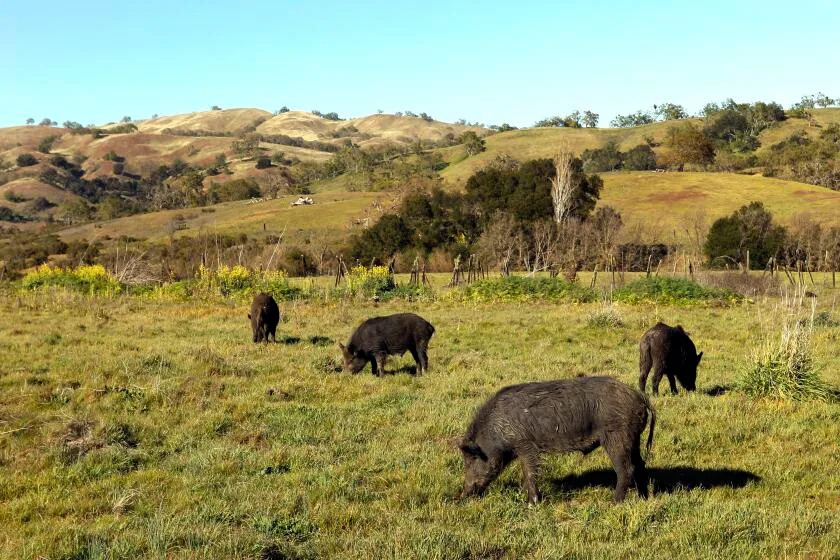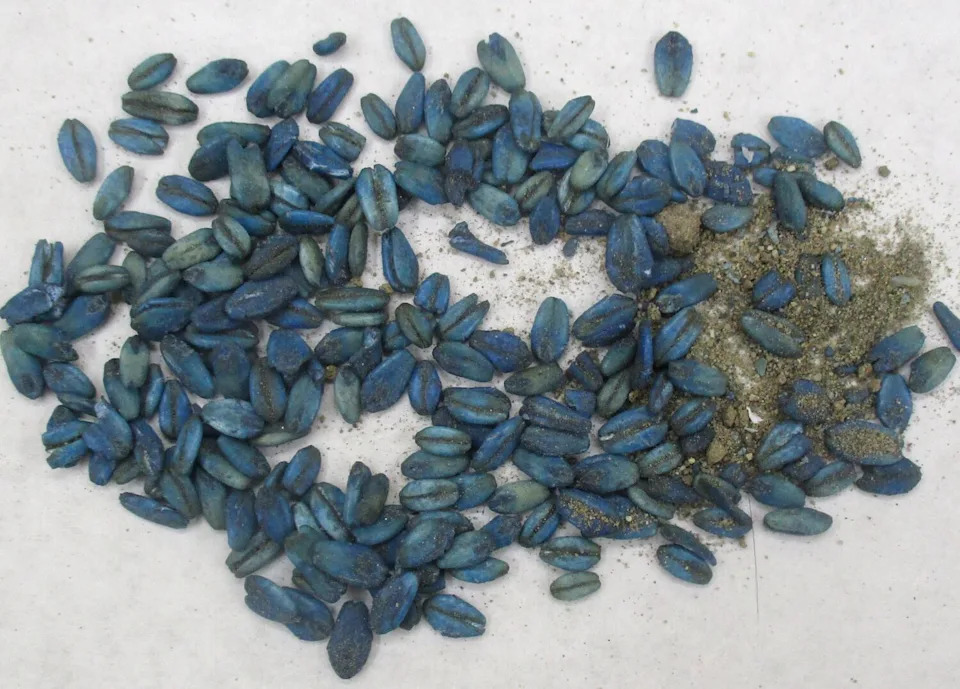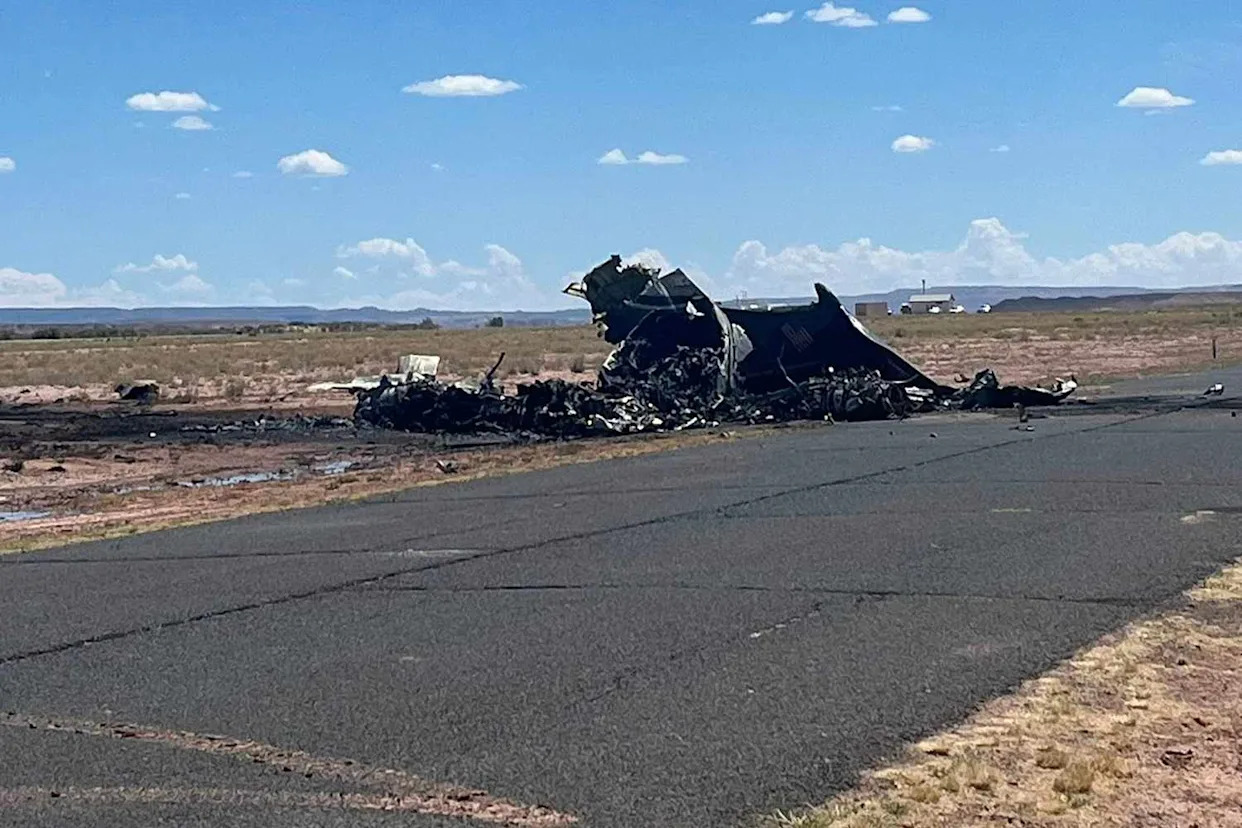
Dan Burton has trapped hundreds of wild pigs for clients of his wildlife control company in Salinas, but even he was startled when he cut one of them open and found blue meat inside.
"I'm not talking about a little blue," said Burton, owner of Urban Trapping Wildlife Control. "I'm talking about neon blue, blueberry blue."
Burton immediately knew what the problem was and relayed the disturbing discovery to Monterey County officials and the California Department of Fish and Wildlife.
The agency is now warning trappers and hunters to keep an eye out for possibly contaminated wildlife in the area, and not to consume the tainted meat, over concerns the blue meat is a sign that the animal may have consumed poison.
"It's just wild," Burton said.
The startling find of wild pigs with bright blue tissue in Monterey County suggests the wild animals have been exposed to anticoagulant rodenticide diphacinone, a popular poison used by farmers and agriculture companies to control the population of rats, mice, squirrels and other small animals, according to a statement from the California Department of Fish and Wildlife.

"Hunters should be aware that the meat of game animals, such as wild pig, deer, bear and geese, might be contaminated if that game animal has been exposed to rodenticides," said Ryan Bourbor, pesticide investigations coordinator with the California Department of Fish and Wildlife.
Officials are urging hunters not to consume any meat from an animal with signs of the blue pigmentation in their meat or fat, and to report the find to officials.
Predators and people who eat animals that were poisoned by diphacinone can suffer "secondary exposure" to the poison because the substance can remain for a time in the organs and tissue of the poisoned animal.
"Generally, more than one feeding is needed to receive a toxic dose," according to a 2023 study, but people and animals that consume the substance can start feeling the effects of the poison, including signs of lethargy.
Read more: Why are scientists dressing pigs in clothes and burying them in Mexico?
Another study published in 2011 found that cooking meat tainted with diphacinone had little effect on the concentration of the poison, and recommended that "consumption of pig meat obtained from areas with active rodent control programs should be avoided."
The California Department of Fish and Wildlife said it became aware of the wild pigs' exposure to rat poison in March, when a trapper in Monterey County reported finding several wild pigs with blue muscle and fat.
The animals were tested by the California Department of Fish and Wildlife's Wildlife Health Lab and found the animals had anticoagulant rodenticide diphacinone in the stomach and liver, according to a statement from the agency.
Rodenticide baits are often dyed so they can be identified as poison, and the unusual blue-colored muscle is a sign that the animal may have eaten the poison, or eaten an animal that had been exposed to the poison.
Officials also warn that the blue coloring may not always be present in animals that have been exposed.
The rodenticide can pose a problem for farmers and agriculture companies that use it to control animals that can destroy or damage crops, but they end up poisoning other wild animals as well, Bourbor said.
Burton said his company discovered the affected animals when it was hired by an agriculture firm in late February and March to trap wild pigs that were going into the firm's fields.
His company traps the pigs and then euthanizes them according to state law, he said. He usually donates the carcass and meat of the pigs to low-income families. But in this case, the pigs were found with bright blue meat and fat when they were opened up.
Read more: Poisoned pelicans fly again after the worst algal bloom in a decade
"I thought, OK that's weird," Burton said.
Burton said he investigated to try to figure out how the pigs' meat had become tainted and found that the animals appeared to be targeting squirrel bait stations in the field, which were being used to control the squirrel population.
"These pigs were seeking [the bait traps] out," Burton said. "I saw them trying to flip it over, breaking them, trying to get access to the poison."
The pigs that were consuming the poisoned bait were not immediately dying because they were consuming bait meant to kill much smaller animals, Burton said. The pigs, which Burton said weighed between 100 and 200 pounds, appeared to be acting normally even though their tissue was visibly affected by the poison.
The poison is also not fast-acting even for small animals, which can stay alive for several days before the poison takes effect, he said.
The pigs were submitted for testing and found to have been exposed to the poison over an extended period of time.
Meanwhile, the firm that hired Burton's company pulled the squirrel traps off the field, Burton said, out of concern that it was drawing in groups of the pigs.
"Our concern is we're seeing multiple animals doing it," Burton said.
Diphacinone, the substance found in the pigs, is mostly prohibited across California, unless it is used by a certified vector control technician, government agency, or at agricultural sites, according to the California Department of Pesticide Regulation.
The prohibition became effective in 2024 as part of a law aimed at protecting wildlife from exposure to the poison.
According to the California Department of Fish and Wildlife, a 2018 study found that about 8.3% of wild pigs tested had traces of anticoagulant rodenticide residue.
Burton said his main concern was that young hunters might not be aware of the signs to look for when hunting the pigs.
The CDFW asks that anyone who comes across an animal with the blue fat or tissue to contact the agency at [email protected] or (916) 358-2790.
This story originally appeared in Los Angeles Times.








Comments